Fall is quickly giving way to winter at the time of this writing. Not the best time for most houseplants, which are pretty solidly dormant at this point.
Does that mean you’ll have to wait for spring if you want to see new flowers and new growth? Luckily not!
During the colder months, store shelves fill with holiday favorites like Christmas cacti, amaryllis, poinsettias, and one of my personal favorites: Cyclamen.
Keep reading for everything you need to know about Cyclamen as a houseplant and how to keep yours alive past the winter season and into the new year!
| Common name(s) | Cyclamen, sowbread, swinebread, Alpine violet |
| Scientific name | Cyclamen sp. |
| Family | Primulaceae |
| Height and spread | Up to a foot in height and width |
| Light | Bright indirect |
| Soil type | Rich, well-draining and acidic |
| Water | Keep lightly moist |
Disclosure: If you shop from my article or make a purchase through one of my links, I may receive commissions on some of the products I recommend.
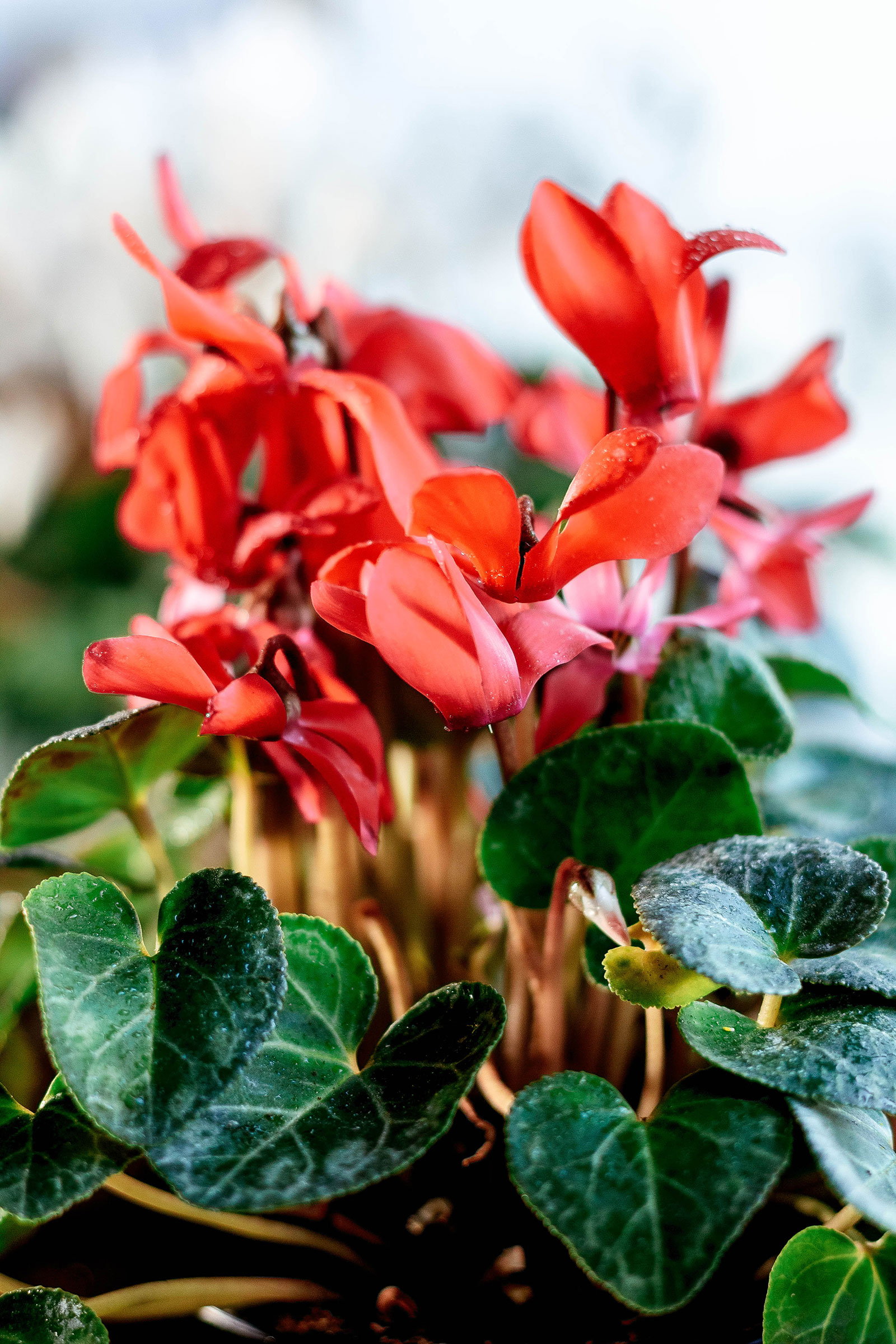
About Cyclamen
Natural habitat
Cyclamen is a genus of 23 plants naturally found in Europe and North Africa, especially in the Mediterranean. The specific habitat of each species can vary pretty drastically, with one found as far north as the southern UK (Cyclamen hederifolium), while others occur much further south. Many are unfortunately now endangered in their natural habitat.
Some Cyclamen are forest plants, while others grow in rockier, open zones. What they all have in common, though, is that they’re perfectly adapted to climates with hot, dry summers and cooler, wetter winters.
Description
Although there are a bunch of different Cyclamen species, they’re all very visually similar. Their most important characteristic is that these are tuberous plants, which die off sometime in spring to protect themselves from the hot and dry Mediterranean summer season.
They pop back up during fall and bloom before spring rolls around. The exact blooming time can vary from September to March.
It’s not difficult to recognize a Cyclamen. The genus features heart-shaped, dark green leaves with intricate, pale green patterns, sprouting from a central point.
The flowers can be white, red, pink, purple, or multicolored, but what they all have in common are their upwards-pointing, swept-back petals that resemble shooting stars. There are even cultivars with ruffly blooms.
Did you know?
Cyclamen seeds are naturally spread by ants.
Cultural significance and uses
Cyclamen are extremely popular both as garden plants (frost-hardy varieties like Cyclamen hederifolium) and houseplants (tender varieties like Cyclamen persicum). They actually have been for hundreds of years now! The tuber has also traditionally been used to make soap in some of the plant’s native growing zones.
Cyclamen are sold for indoor display on a massive scale when they start to bloom from fall onwards, helping to cheer up homes with their bright and long-lasting flowers during the darker months.
Read more: Festive holiday houseplants you can grow (that aren’t poinsettias)
These classic winter bloomers start showing up in grocery stores and garden centers between Thanksgiving and Christmas, and can survive year-round as long as you replicate their natural environment as closely as possible.
Did you know?
Common names for Cyclamen include sowbread and swinebread. This is because Cyclamen tubers make a tasty snack for pigs, which like to dig for them.
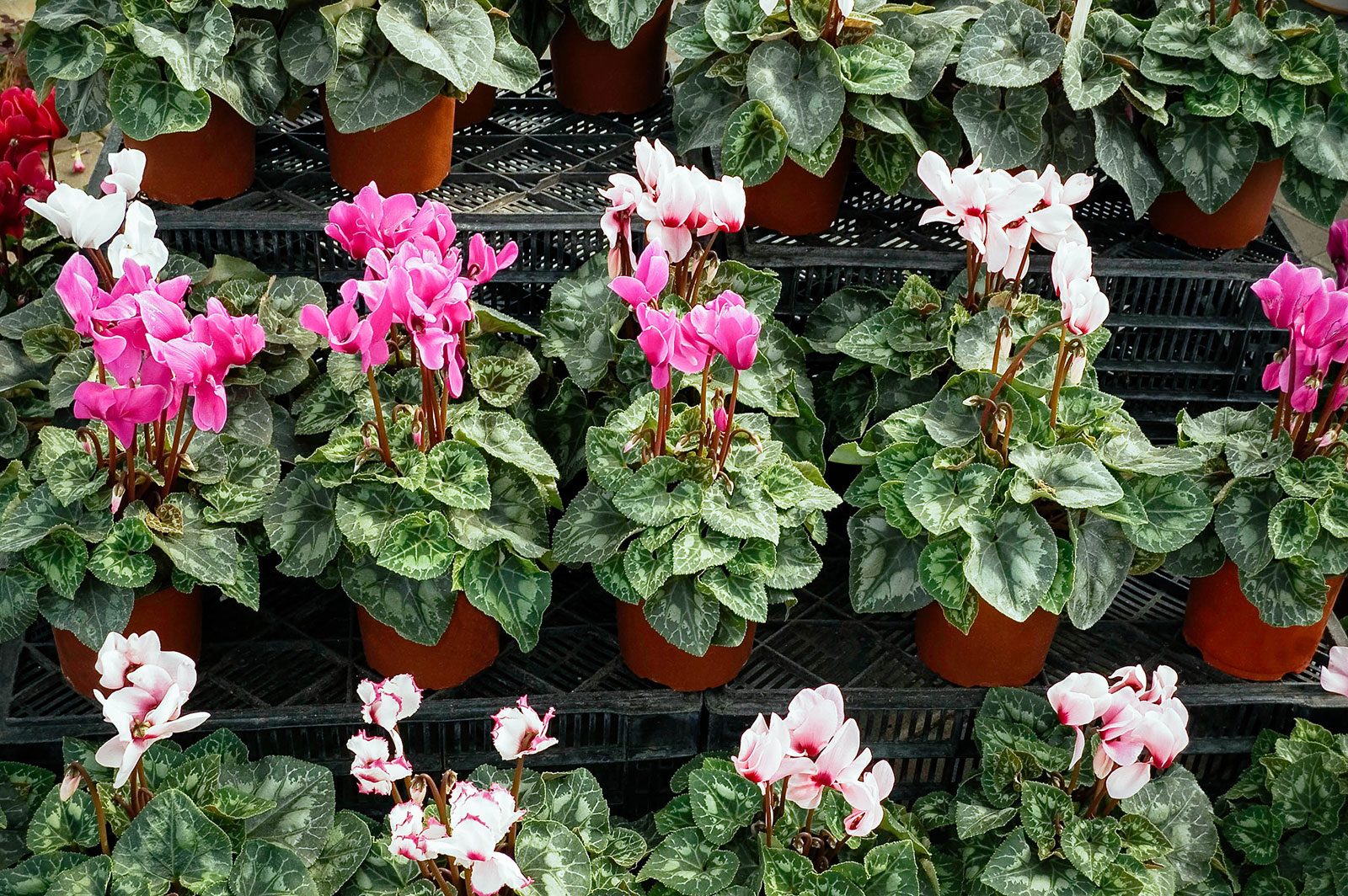
Cyclamen varieties
Although there are many different species of Cyclamen, only a few of them are commonly grown. Some of the more popular species for use as houseplants and in gardens are:
- Cyclamen persicum (florist’s Cyclamen): Easily the most common Cyclamen, this is the one you’ll usually see for sale as a houseplant. It’s not frost-hardy.
- Cyclamen hederifolium (ivy-leaved Cyclamen): Naturally occurring pretty far north for a Cyclamen, this one is suitable for outdoor use. It doesn’t mind a bit of frost and will return year after year to brighten up your garden with fall flowers.
- Cyclamen purpurascens (purple Cyclamen): Not nearly as easy to find as persicum and hederifolium, this is a frost-hardy Cyclamen that blooms a bit earlier in most climates, from mid-summer to early fall.
- Cyclamen coum (eastern sowbread): A much later bloomer, this one might hold on to its compact flowers until early spring. It’s very frost-hardy.
Plenty of selectively bred cultivars exist for each of these species. I’m not even going to try to list them all! Take a peek at your local plant store to get an idea of the endless different leaf patterns and flower colors and shapes.
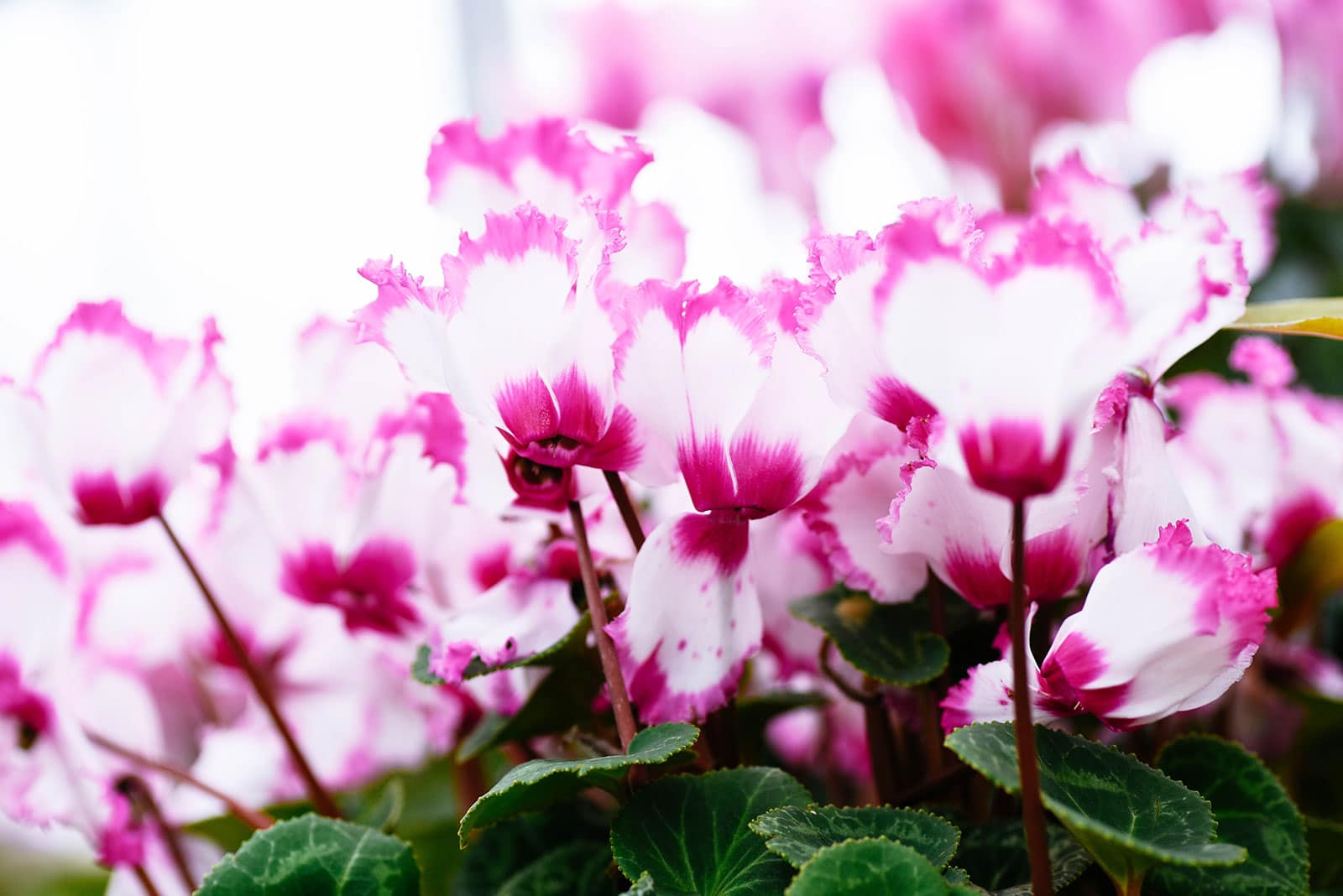
Caring for Cyclamen indoors
Funny thing: These plants don’t particularly like being indoors. They’re actually not the best houseplants!
As I mentioned above, they prefer cool and wet winters, whereas we like to stick them in our warm and dry living rooms for their pretty flowers.
Is an indoor Cyclamen doomed to fail then? Luckily, no.
With some easy measures, you’ll be able to reach a compromise with your plant and enjoy its flowers year after year.
Recommended products for Cyclamen plant care:
- Espoma Organic African Violet Potting Mix
- Black Gold African Violet Potting Mix
- Emily’s Naturals Neem Oil Plant Spray Kit
- Barebones Living Walnut Scissors
Light and temperature
A growing Cyclamen appreciates plenty of light. It’s often noted that indirect light is better than direct sun, but since Cyclamen are only active in winter when the sun isn’t nearly as harsh, a few rays here and there are unlikely to cause problems.
Overdoing it a bit is better than giving your plant too little light, as that’ll result in stretched, limp leaves and just an overall sad look.
When it comes to temperature, it’s important to keep your Cyclamen away from heat sources like radiators and fireplaces.
They like it cool and thrive in temperatures that drop as low as 40°F at night and rise into the 60s°F during the day. This makes them a good option for those chillier windowsills that your tropical plants might not like.
Higher temps will shorten a Cyclamen’s lifespan and blooming time, which is a shame because they can continue to bloom for months on end.
Once your Cyclamen has gone dormant, the tuber will appreciate a relatively cool and dark spot. You can keep it half-buried in a bucket in a shed, for example.
Did you know?
Because the average home temperatures can confuse a Cyclamen, yours may not go fully dormant during the summer. It might end up looking sad and sparse with yellowing foliage for a few months, but then perk back up once fall rolls back around.
Water and humidity
A Cyclamen likes a good drink now and then when it’s actively growing, but the tuber is sensitive to rot. Its leaves and flowers also don’t tolerate getting wet.
This makes the species a good candidate for bottom watering, where you set the planter on a water-filled tray and let the soil soak up the moisture through the drainage holes.
If your Cyclamen is looking lush and growing well, you can keep the soil lightly moist. Let the first inch or two of the soil dry out, but avoid it drying completely to the point of wilting.
If the plant is starting to go into dormancy, you’ll have to be a bit more careful in order to prevent tuber rot. Let the soil dry out further and eventually stop watering entirely when all of the leaves have died off.
Soil and planting
Because you’ll probably want to bottom water your Cyclamen, and because good drainage in general is one of the keys to keeping houseplants happy, you’ll want to go for a planter with a drainage hole.
A cheap plastic nursery planter placed inside a decorative overpot allows you to easily take your Cyclamen out for watering and then place it back once it’s had a drink.
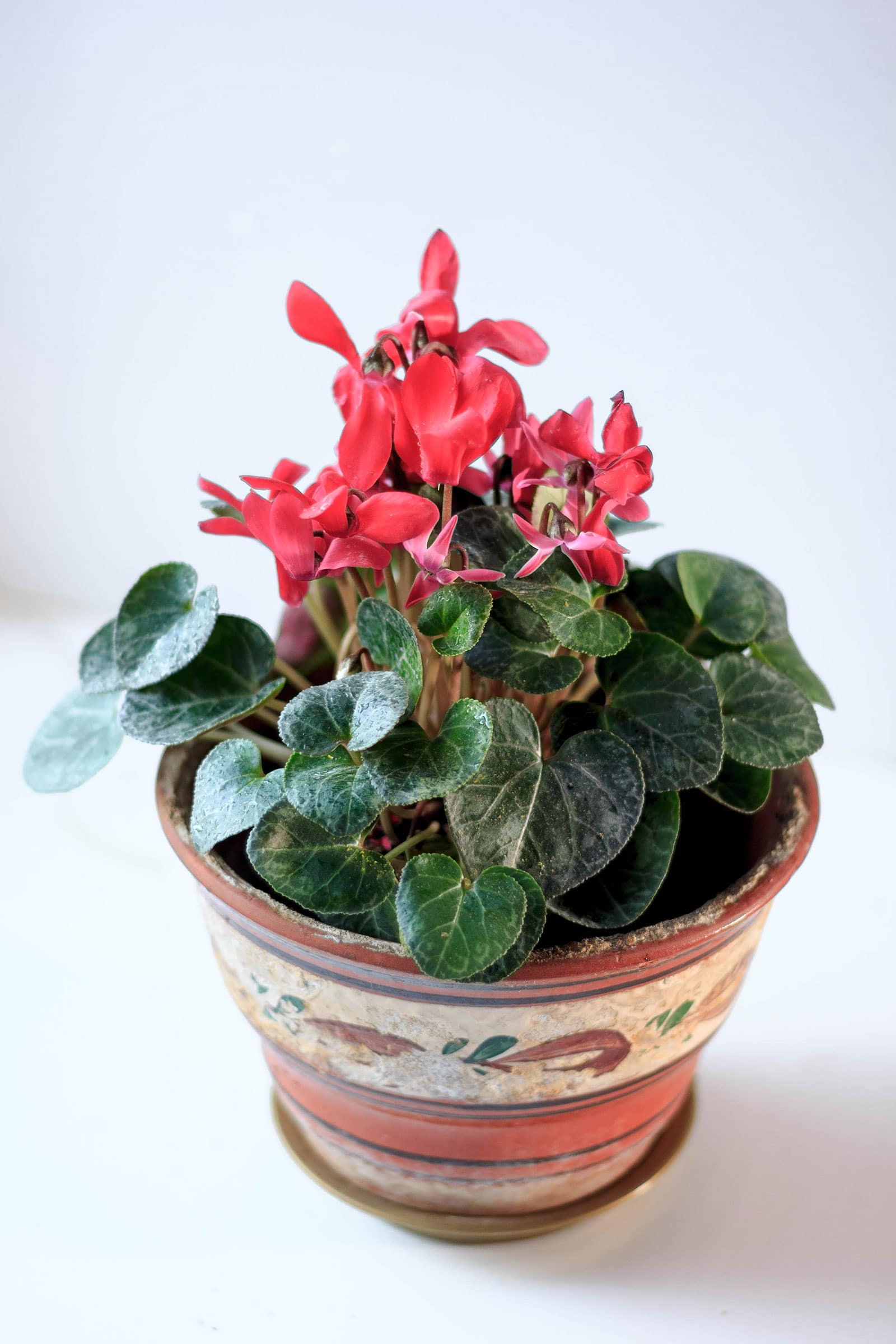
As for soil, a mixture that’s rich but well-draining is ideal. The species likes it slightly acidic, so a bit of peat mixed into the soil can be helpful. If you don’t want to mix your own, you could consider a commercial African violet soil mix like this one.
Fertilizing
Given the fact that your Cyclamen has to grow from a bare tuber every year, it will appreciate some fertilizer during the growing and blooming period. Don’t overdo it though, as too much fertilizer can inhibit blooming.
You can use a diluted normal liquid houseplant fertilizer once or twice a month. Some growers also like to mix some compost or worm castings into their Cyclamen soil for an extra boost.
Recommended fertilizers for Cyclamen:
- Houseplant Resource Center Liquid Fertilizer for Houseplants
- Instant Biologics Instant Plant Food (Fizzing Nutrient Tablets)
- Wiggle Worm Soil Builder Pure Worm Castings
- Brut Worm Farms Worm Castings
Pruning
A Cyclamen will need regular pruning once it starts to reach the end of its blooming period. Leaves begin to yellow and die off, which isn’t the prettiest thing to look at!
Luckily, you can just snip off dead foliage and flowers and discard them. They’ll grow back next year.
Dividing or repotting
If you’d like to give your Cyclamen some fresh soil or want to change its planter, the best time to do so is when it’s limping along or fully dormant by the end of summer, right before active growth starts back up. You can also divide the plant at this time if the tuber is starting to get a bit big for your taste.
Because you’ll have to uproot the tuber to divide, this is best done if you were already going to repot or store it; I’ll describe how to do so below.
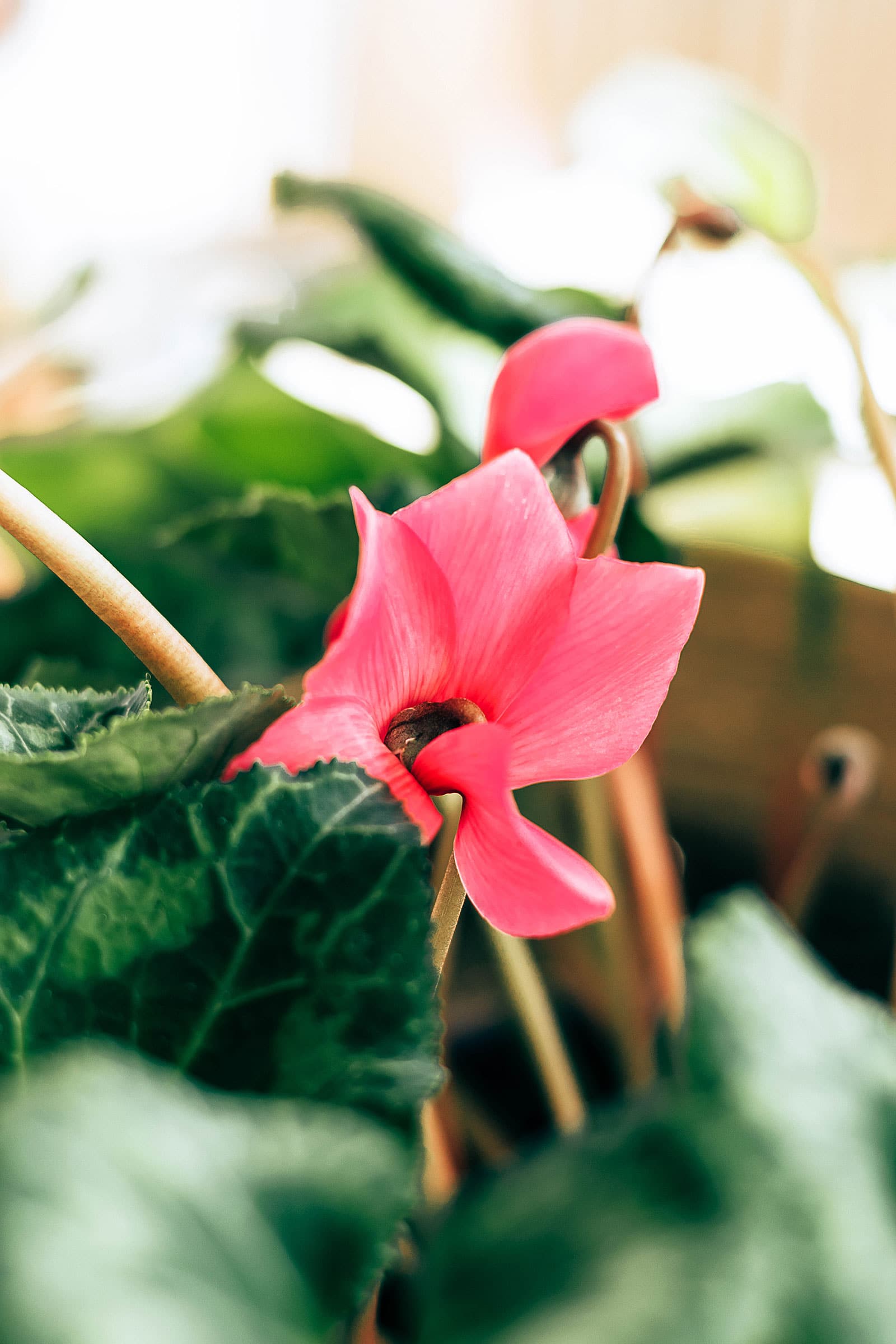
Propagating Cyclamen
Although most of the normal propagation methods like stem propagation don’t really work with this houseplant, you can still multiply yours.
To propagate a Cyclamen, remove the tuber from its planter or container in fall. You can now cut it into multiple pieces and root these for the upcoming blooming season. Use sterilized equipment, because the tubers are vulnerable to rot after cutting.
If your Cyclamen flowered and the blooms were pollinated, you might find small seed pods on your plant. Yes, these can be used to grow your own Cyclamen plants from seed! The success rate varies due to hybridization and it’s a very slow process, but it can be done.
Here’s how:
- Soak the Cyclamen seeds for 12 hours.
- Prepare a planter with normal Cyclamen soil. (This potting soil is my favorite.)
- Sprinkle the seeds on top of the soil.
- Place the container in a dark place to imitate the winter conditions in which Cyclamen seeds naturally germinate.
- Keep the temperature stable at around 60°F and keep the soil moist.
- Once the seedlings appear, you can move their pots to a normal, bright spot.
- You’ll probably be able to enjoy your homegrown flowers next winter, about 15 months after sowing.
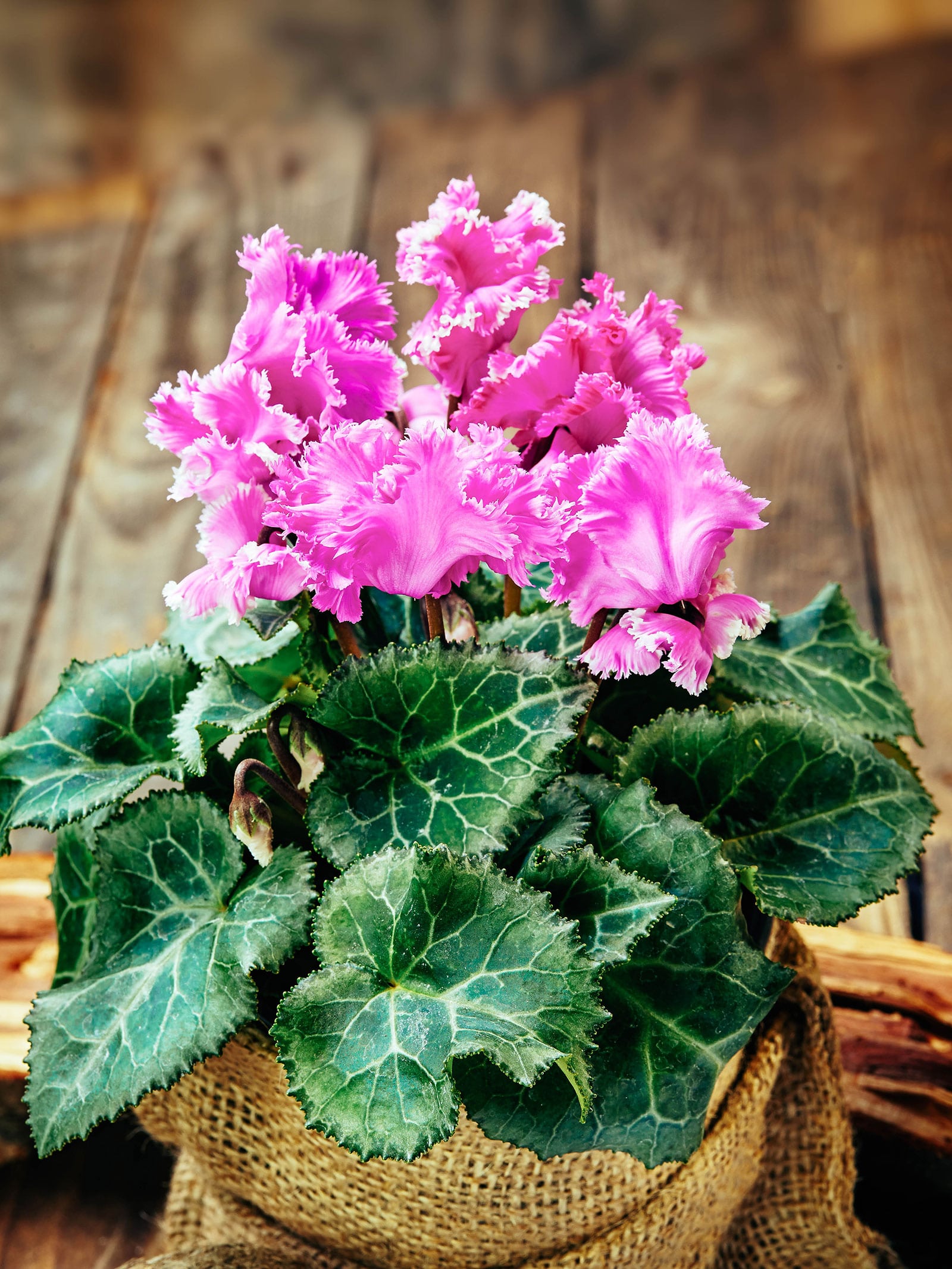
How can I make my Cyclamen bloom?
Wondering how to make sure your Cyclamen blooms abundantly this winter? The best way to make sure you get plenty of flowers is to respect the tuber’s natural yearly cycle. Here’s a rough outline, although your mileage may vary according to the light levels and temperature in your home:
- Once your plant begins to die off around April or May, reduce waterings. Don’t worry, you’re not killing it.
- Dig up the tuber for storage or just move the whole planter to a cool and dry spot for the entirety of summer. Don’t water, or you’ll cause the tuber to rot.
- Once summer ends around September or October, you can go ahead and fetch the Cyclamen tuber to place it back in its regular indoor growing spot. Not too warm, please! It may already have started to sprout by itself at this point.
- Give the soil a good soak to wake up your plant. New foliage should start appearing soon, and with a solid watering and fertilizer schedule, you’ll see plenty of flower buds appearing in no time.
Common questions about Cyclamen
How long do potted Cyclamen last?
As an indoor plant, Cyclamen flowers for at least eight weeks, easy, and has the potential to live for decades with proper care. In fact, a well-tended Cyclamen can continue to grow and bloom for up to 100 years! (Just like another winter favorite, Christmas cactus, which can bloom year after year.)
Is there a difference between indoor and outdoor Cyclamen?
In mild climates that don’t get frost, most garden centers sell florist’s Cyclamen (Cyclamen persicum) and do not distinguish between indoor or outdoor varieties. And there’s no need to—in that type of environment, florist’s Cyclamen behaves the same whether it’s grown as an indoor plant or an outdoor perennial.
In other regions, however, you’ll likely find both florist’s Cyclamen and hardy Cyclamen (Cyclamen hederifolium) for sale. Hardy Cyclamen can be grown outside in cooler climates, so if you’re looking to fill a garden bed, this frost-tolerant Cyclamen is the type you want.
Is Cyclamen toxic to cats and dogs?
According to the ASPCA, unfortunately, yes. Cyclamen are toxic to both humans and animals due to their triterpenoid saponin content, especially in the tuber. This compound is an antifungal meant to protect the plant, but it’s also very irritating and can cause convulsions and paralysis.
Ingestion of large quantities of Cyclamen is unlikely (the taste is apparently not very nice!) but can be dangerous, so keep this one away from pets and kids.
Sources:
- Spoerke, D. G., Spoerke, S. E., Hall, A., & Rumack, B. H. (1987). Toxicity of Cyclamen persium(Mill). Veterinary and human toxicology, 29(3), 250-251.
- Yesson, C., & Culham, A. (2006). A phyloclimatic study of Cyclamen. BMC Evolutionary Biology, 6(1), 1-23.


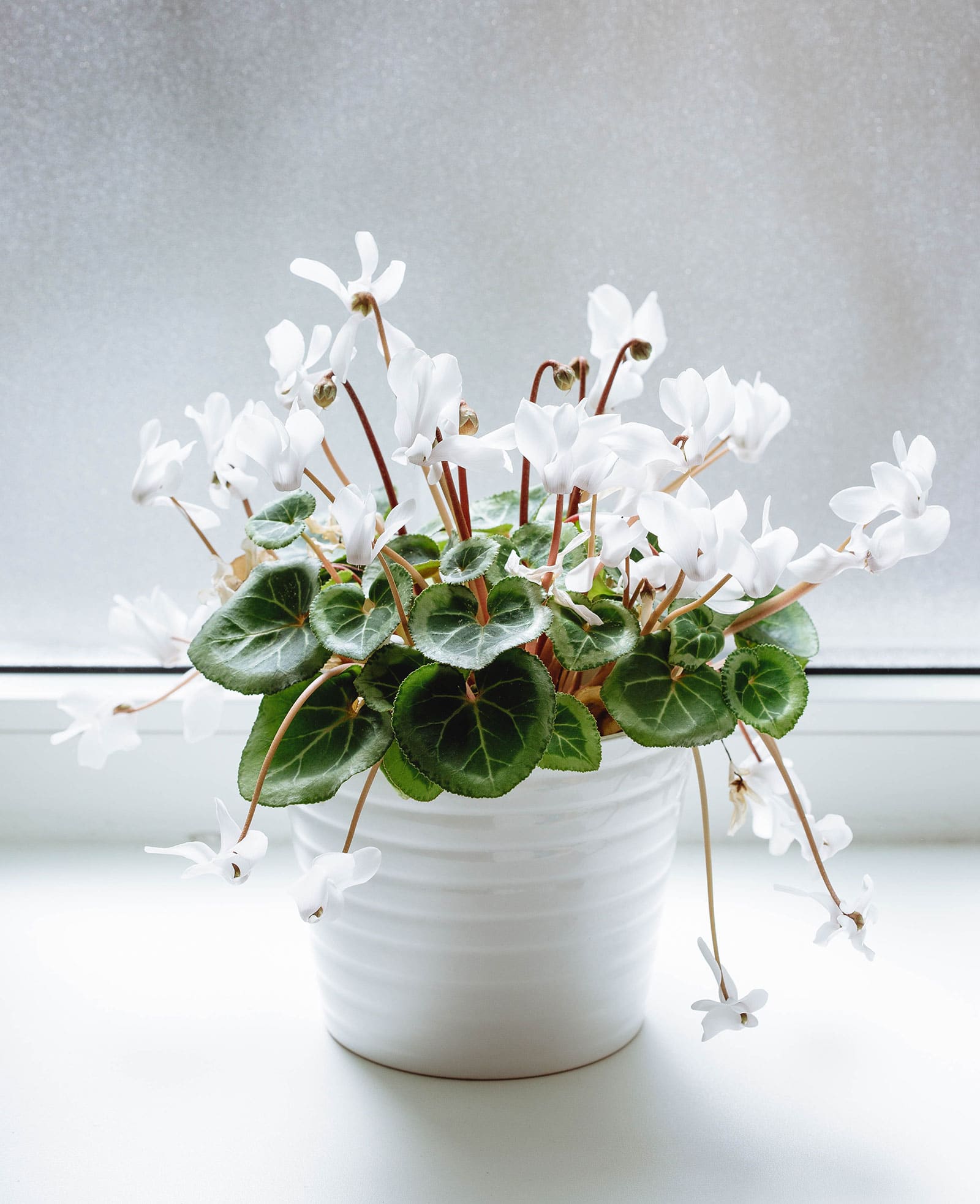













Thanks for the information, I brought my cyclamen in from last years flower garden, it looked great all winter and 3 weeks ago I moved it because my grandkids were coming for spring break. I thought I killed it by moving it! Seems it’s just doing what cyclamen do in April. Thank you so much again!